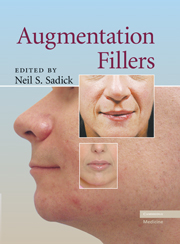Book contents
- Frontmatter
- Contents
- LIST OF CONTRIBUTORS
- Ch. 1 Application of Fillers
- Ch. 2 Approach to Choosing the Ideal Filler
- Ch. 3 Patient Selection, Counseling, and Informed Consent
- Ch. 4 Hyaluronic Acid Skin Derivatives
- Ch. 5 Collagen Products
- Ch. 6 Radiesse
- Ch. 7 ArteFill
- Ch. 8 Augmentation Fillers in Cosmetic Dermatology: Silicone
- Ch. 9 Advanta Expanded Polytetrafluoroethylene Implants
- Ch. 10 Sculptra
- Ch. 11 Lipo Transfer
- Ch. 12 BioAlcamid®
- Ch. 13 Combination of Approaches in Augmentation Fillers in Cosmetic Dermatology
- Ch. 14 Filling Complications
- Ch. 15 Postprocedure Management and Patient Instructions
- Ch. 16 Conclusion: Future Trends in Fillers
- INDEX
- References
Ch. 16 - Conclusion: Future Trends in Fillers
Published online by Cambridge University Press: 26 February 2010
- Frontmatter
- Contents
- LIST OF CONTRIBUTORS
- Ch. 1 Application of Fillers
- Ch. 2 Approach to Choosing the Ideal Filler
- Ch. 3 Patient Selection, Counseling, and Informed Consent
- Ch. 4 Hyaluronic Acid Skin Derivatives
- Ch. 5 Collagen Products
- Ch. 6 Radiesse
- Ch. 7 ArteFill
- Ch. 8 Augmentation Fillers in Cosmetic Dermatology: Silicone
- Ch. 9 Advanta Expanded Polytetrafluoroethylene Implants
- Ch. 10 Sculptra
- Ch. 11 Lipo Transfer
- Ch. 12 BioAlcamid®
- Ch. 13 Combination of Approaches in Augmentation Fillers in Cosmetic Dermatology
- Ch. 14 Filling Complications
- Ch. 15 Postprocedure Management and Patient Instructions
- Ch. 16 Conclusion: Future Trends in Fillers
- INDEX
- References
Summary
The present treatise has outlined the major advances in the development and utilization of fillers in the United States. Fillers are playing an ever-expanding role within this clinical setting. Combination programs employing toxins, fillers, light source, and radiofrequency technologies make up the backbone of noninvasive photorejuvenation programs. The therapeutic armentarium of fillers available in this country continues to evolve annually. There are six major trends in next-generation fillers that have evolved in this regard. A well-accepted and standardized classification schema of these agents has yet to be evolved.
LONGER ACTING FILLING AGENTS
There is definitely a trend toward longer acting fillers. In our busy world and for economic reasons, individuals would like to minimize the number of filler treatments that are necessary while still maintaining effect. The major question that is not universally accepted is what is that optimal duration of effect? Most physicians feel that an intermediate-acting filler with duration of twelve to eighteen months is optimal. This allows for longevity greater than older generation collagens and traditional hyaluronic acid derivatives; however, if there are adverse sequelae, it will resolve within a reasonable period of time, although one may expect as we move down the road that this timeline may continue to expand.
SITE-SPECIFIC FILLERS
Another major trend in fillers is specific capabilities. This means that they have clinical and physical characteristics that are uniquely beneficial for given anatomic areas. Examples of such site-specific areas are the lips and tear troughs, where lighter fillers with greater laminar flow characteristics would be more beneficial.
- Type
- Chapter
- Information
- Augmentation Fillers , pp. 149 - 152Publisher: Cambridge University PressPrint publication year: 2010



